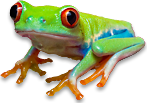by
Published on August 5th, 2013 02:35 AM
Number of Views: 528753

The Golden Poison Frog of Colombia is probably the largest and certainly the most controversial dart frog in the world. Join us as we learn about this stunning amphibian and describe everything there is to know about its care and breeding in captivity.
Article, Photos and Videos by John Clare
Background
The Golden Poison Frog, scientific name Phyllobates terribilis, was first described to science in 1978 by Charles W. Myers, John W. Daly and Borys Malkin. While the species was new to science, the native Emberá Indians of the Cauca region of Colombia had made use of the frog’s powerful toxins for centuries.
Dr. Daly in particular was famous for studying the chemical compounds produced by organisms like frogs, known as natural products, for possible medicinal applications. To put this in context, most anti-cancer drugs used today are toxins whose dosage is tuned for maximum anti-cancer effect but minimal toxicity to the human body. Much of the inspiration for today’s top pharmaceutical drugs comes from chemical compounds discovered in nature. Every day, teams of chemists and biologists travel to remote parts of the world in search of plants and animals that may produce valuable chemical compounds new to science. These compounds could lead to potent non-addictive painkillers, more effective anti-cancer drugs, and possible cures for other terminal illnesses that claim so many
...


 Currently Active Users
Currently Active Users
